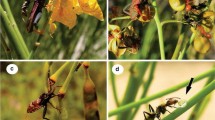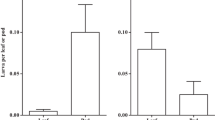Abstract
Ant–plant interactions often are mediated by extrafloral nectar (EFN) composition that may influence plant visitation by ants. Over a 300 km range in the Indian Western Ghats, we investigated the correlation between the EFN composition of the myrmecophytic ant-plant Humboldtia brunonis (Fabaceae) and the number and species of ants visiting EFN. EFN composition varied among H. brunonis populations and between plant organs (floral bud vs. young leaf EFN). In general, EFN was rich in sugars with small quantities of amino acids, especially essential amino acids, and had moderate invertase activity. In experiments at the study sites with sugar and amino acid solutions and with leaf or floral bud EFN mimics, dominant EFN-feeding ants differentiated between solutions as well as between mimics. The castration parasite Crematogaster dohrni (northern study site) was the least selective and did not exhibit any clear feeding preferences, while the largely trophobiont-tending non-protective Myrmicaria brunnea (middle study site) preferred higher sucrose concentrations and certain essential/non-essential amino acid mixtures. The mutualistic Technomyrmex albipes (southern study site) preferred sucrose over glucose or fructose solutions and consumed the leaf EFN mimic to a greater extent than the floral bud EFN mimic. This young leaf EFN mimic had low sugar concentrations, the lowest viscosity and sugar:amino acid ratio, was rich in essential amino acids, and appeared ideally suited to the digestive physiology of T. albipes. This preference for young leaf EFN may explain the greater protection afforded to young leaves than to floral buds by T. albipes, and may also help to resolve ant–pollinator conflicts. The differential response of dominant ants to sugar, amino acids, or solution viscosity suggests that plants can fine-tune their interactions with local ants via EFN composition. Thus, EFN can mediate local partner-choice mechanisms in ant–plant interactions.






Similar content being viewed by others
References
Anderson, M. J. 2001. A new method for non-parametric multivariate analysis of variance. Austral Ecol. 26:32–46.
Baker, H. G., Opler, P. A., and Baker, I. 1978. A comparison of the amino acid complements of floral and extrafloral nectars. Bot. Gaz. 139:322–332.
Basu, P. 1997. Seasonal and spatial patterns in ground foraging ants in a rain forest in the Western Ghats, India. Biotropica 29:489–500.
Blüthgen, N., and Fiedler, K. 2004. Preferences for sugars and amino acids and their conditionality in a diverse nectar-feeding ant community. J. Anim. Ecol. 73:155–166.
Blüthgen, N., Gottsberger, G., and Fiedler, K. 2004. Sugar and amino acid composition of ant-attended nectar and honeydew sources from an Australian rainforest. Austral Ecol. 29:418–429.
Blüthgen, N., Verhaagh, M., Goitía, W., Jaffé, K., Morawetz, W., and Barthlott, W. 2000. How plants shape the ant community in the Amazonian rainforest canopy: the key role of extrafloral nectaries and homopteran honeydew. Oecologia 125:229–240.
Caldwell, D. I., and Gerhardt, K. O. 1986. Chemical analysis of peach extrafloral nectary exudate. Phytochemistry 25:41–43.
Chamberlain, S. A., and Holland, J. N. 2008. Density-mediated context-dependent consumer-resource interactions between ants and extrafloral nectar plants. Ecology 89:1364–1374.
Cook, S. C., and Davidson, D. W. 2006. Nutritional and functional biology of exudate-feeding ants. Entomol. Exp. Appl. 118:1–10.
Davidson, D. W. 1997. The role of resource imbalances in the evolutionary ecology of tropical arboreal ants. Biol. J. Linn.Soc. 61:153–181.
Davidson, D. W., and Cook, S. C. 2008. Tropical arboreal ants: linking nutrition to roles in rainforest ecosystems. pp. 334–348 in W. CARSON and S. SCHNITZER (eds.). Tropical Forest Community Ecology. Wiley-Blackwell, UK.
Davidson, D. W., and McKey, D. B. 1993. The evolutionary ecology of symbiotic ant-plant relationships. J. Hymen. Res. 2:13–83.
Davidson, D. W., Cook, S. C., and Snelling, R. R. 2004. Liquid-feeding performances of ants (Formicidae): ecological and evolutionary implications. Oecologia 139:255–266.
Detrain, C., Verheggen, F. J., Diez, L., Wathelet, B., and Haubruge, E. 2010. Aphid–ant mutualism: how honeydew sugars influence the behaviour of ant scouts. Physiol. Entomol. 35:168–174.
Gaume, L., Zacharias, M., and Borges, R. M. 2005a. Ant–plant conflicts and a novel case of castration parasitism in a myrmecophyte. Evol. Ecol. Res. 7:435–452.
Gaume, L., Zacharias, M., Grosbois, V., and Borges, R. M. 2005b. The fitness consequences of bearing domatia and having the right ant partner: experiments with protective and non-protective ants in a semi-myrmecophyte. Oecologia 145:76–86.
Gaume, L., Shenoy, M., Zacharias, M., and Borges, R. M. 2006. Co-existence of ants and an arboreal earthworm in a myrmecophyte of the Indian Western Ghats: anti-predation effect of the earthworm mucus. J. Trop. Ecol. 22:1–4.
González-Teuber, M., and Heil, M. 2009a. Nectar chemistry is tailored for both attraction of mutualists and protection from exploiters. Plant Sign. Behav. 4:1–5.
González-Teuber, M., and Heil M. 2009b. The role of extrafloral nectar amino acids for the references of facultative and obligate ant mutualists. J. Chem. Ecol. 35:459–468.
Heil, M., and McKey, D. B. 2003. Protective ant–plant interactions as model systems in ecological and evolutionary research. Annu. Rev. Ecol. Evol. Syst. 34:425–453.
Heil, M., Fiala, B., Baumann, B., and Linsenmair, K. E. 2000. Temporal, spatial and biotic variations in extrafloral nectar secretion by Macaranga tanarius. Func. Ecol. 14:749–757.
Heil, M., Rattke, J., and Boland, W. 2005. Postsecretory hydrolysis of nectar sucrose and specialization in ant/plant mutualism. Science 308:560–563.
Heil, M., González-Teuber, M., Clement, L. W., Kautz, S., Verhaagh, M., and Silva-Bueno, J. C. 2009. Divergent investment strategies of Acacia myrmecophytes and the coexistence of mutualists and exploiters. Proc. Natl. Acad. Sci. USA 43:18091–18096.
Herrera, C.M., Pérez, R., and Alonso, C. 2006. Extreme intraplant variation in nectar sugar composition in an insect-pollinated perennial herb. Am. J. Bot. 93:575–581.
Inouye, D. W., and Inouye R. S. 1980. The amino acids of extrafloral nectar from Helianthella quinquenervis (Asteraceae). Am. J. Bot. 67:1394–1396.
Kay, A. 2004. The relative availabilities of complementary resources affect the feeding preferences of ant colonies. Behav. Ecol. 15:63–70.
Keeler, K. H. 1977. The extrafloral nectaries of Ipomoea carnea (Convolvulaceae). Am. J. Bot. 64:1182–1188.
Koptur, S. 1979. Facultative mutualism between weedy vetches bearing extrafloral nectaries and weedy ants in California. Am. J. Bot. 66:1016–1020.
Koptur, S. 1992. Extrafloral nectary-mediated interactions between insects and plants. pp. 81–129 in E. A. BERNAYS (ed.). Insect-Plant Interactions. CRC Press, Boca Raton.
Koptur, S. 1994. Floral and extrafloral nectars of Costa Rican Inga trees: a comparison of their constituents and composition. Biotropica 26:276–284.
Koptur, S., and Truong, N. 1998. Facultative ant–plant interactions: nectar sugar preferences of introduced pest ant species in south Florida. Biotropica 30:179–189.
Kost, C., and Heil, M. 2005. Increased availability of extrafloral nectar reduces herbivory in Lima bean plants (Phaseolus lunatus, Fabaceae). Basic Appl. Ecol. 6:237–248.
Lanza, J. 1988. Ant preferences for Passiflora nectar mimics that contain amino acids. Biotropica 20:341–344.
Lanza, J., Smith, G. C., Sack, S., and Cash, A. 1995. Variation in nectar volume and composition of Impatiens capensis at the individual, plant, and population levels. Oecologia 102:113–119.
McKey, D. B. 1994. Legumes and nitrogen: the evolutionary ecology of a nitrogen-demanding lifestyle. pp. 211–228 in J. I. SPRENT AND D. McKey (eds.). Advances in Legume Systematics, Part 5. Royal Botanic Gardens, Kew, U. K.
Ness, J. H. 2006. A mutualism’s indirect costs: the most aggressive plant bodyguards also deter pollinators. Oikos 113:506–514.
Ness, J. H., Morris, W. F., and Bronstein, J. L. 2009. For ant-protected plants, the best defense is a hungry offense. Ecology 90:2823–2831.
Nicklen, E. F, and Wagner, D. 2006. Conflict resolution in an ant–plant interaction: Acacia constricta traits reduce ant costs to reproduction. Oecologia 148:81–87.
Nicolson, S. W. 2007. Amino acid concentrations in the nectars of Southern African bird-pollinated flowers, especially Aloe and Erythrina. J. Chem. Ecol. 33:1707–1720.
Oksanen, J., Blanchet F. G., Kindt R., Legendre P., O’hara R. B., Simpson G. L., Solymos P., Stevens M. H. H, and Wagner H. 2011. Vegan: community ecology package. Version 1.17-4. http://cran.r-project.org/web/packages/vegan
Palmer, T. M., and Brody, A. K. 2007. Mutualism as reciprocal exploitation: African plant-ants defend foliar but not reproductive structures. Ecology 88:3004–3011.
Pate, J. S., Peoples, M. B., Storer, P. J., and Atkins, C. A. 1985. The extrafloral nectaries of cowpea (Vigna unguiculata (L.) Walp.) II. Nectar composition, origin of solutes, and nectary functioning. Planta 166:28–38.
Raine, N. E., Willmer, P., and Stone, G. N. 2002. Spatial structuring and floral avoidance behavior prevent ant–pollinator conflict in a Mexican ant-acacia. Ecology 83:3086–3096.
Ramesh, B. R., and Pascal, J. P. 1997. Atlas of Endemics of the Western Ghats (India): Distribution of Tree Species in the Evergreen and Semi-evergreen Forests. French Institute of Pondicherry, Pondicherry, India.
Rudgers, J. A., and Gardener, M. C. 2004. Extrafloral nectar as a resource mediating multispecies interactions. Ecology 85:1495–1502.
Rudgers, J. A., Savage, A. M., and Rúa, M. A. 2010. Geographic variation in a facultative mutualism: consequences for local arthropod composition and diversity. Oecologia 163:985–996.
Schemske, D. W. 1982. Ecological correlates of a neotropical mutualism: ant assemblages at Costus extrafloral nectaries. Ecology 63:932–941.
Schroder, D., Deppisch, H., Obermayer, M., Krohne, G., Stackebrandt, E., Hölldobler, B., Goebel, W., and Gross, R. 1996. Intracellular endosymbiotic bacteria of Camponotus species (carpenter ants): systematics, evolution and ultrastructural characterization. Mol. Microbiol. 21:479–489.
Shenoy, M. and Borges, R. M. 2010. Geographical variation in an ant–plant interaction correlates with domatia occupancy, local ant diversity and interlopers. Biol. J. Linn. Soc. 100:538–551.
Simpson S. J., and Raubenheimer, D. 1996. Feeding behaviour, sensory physiology and nutrient feedback: a unifying model. Entomol. Exp. Appl. 80:55–64.
Tinti, J. M., and Nofre, C. 2001. Responses of the ant Lasius niger to various compounds perceived as sweet in humans: a structure-activity relationship study. Chem. Senses 26:231–237.
Völkl, W., Woodring, J., Fischer, M., Lorenz, M. W., and Hoffmann, K. H. 1999. Ant-aphid mutualisms: the impact of honeydew production and honeydew sugar composition on ant preferences. Oecologia 118:483–491.
Wagner, D., and Nicklen, E. F. 2010. Ant nest location, soil nutrients and ant-associated plants: does extrafloral nectar attract ant nests and thereby enhance plant nutrition? J. Ecol. 98:614–624.
Woodring, J., Wiedemann, R., Fischer, M. K., Hoffmann, K. H., and Völkl, W. 2004. Honeydew amino acids in relation to sugars and their role in the establishment of ant-attendance hierarchy in eight species of aphids feeding on tansy (Tanacetum vulgare). Physiol. Entomol. 29:311–319.
Acknowledgements
This work was funded by the Ministry of Environment and Forests, Government of India. We are grateful to T. M. Musthak Ali for ant identification. We thank Anupama, Karthik, Megha, Priya, Shaji, Sivan, Sudheesh, and G. Yathiraj for assistance, P. Balaram and S. Chandrasekaran for help with the GC-MS analysis, and the Karnataka Forest Department for research permissions. We are especially grateful to Yuvaraj Ranganathan for doing the multivariate analyses and for help with the final figures. We thank Judie Bronstein, Doyle McKey, Martin Heil, and an anonymous reviewer for helpful comments on the manuscript.
Author information
Authors and Affiliations
Corresponding author
Electronic supplementary material
Below is the link to the electronic supplementary material.
ESM 1
(DOC 396 kb)
Rights and permissions
About this article
Cite this article
Shenoy, M., Radhika, V., Satish, S. et al. Composition of Extrafloral Nectar Influences Interactions between the Myrmecophyte Humboldtia brunonis and its Ant Associates. J Chem Ecol 38, 88–99 (2012). https://doi.org/10.1007/s10886-011-0052-z
Received:
Revised:
Accepted:
Published:
Issue Date:
DOI: https://doi.org/10.1007/s10886-011-0052-z




